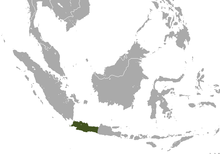Javan slow loris
| Javan slow loris | |
|---|---|
 |
|
| Scientific classification | |
| Kingdom: | Animalia |
| Phylum: | Chordata |
| Class: | Mammalia |
| Order: | Primates |
| Family: | Lorisidae |
| Genus: | Nycticebus |
| Species: | N. javanicus |
| Binomial name | |
|
Nycticebus javanicus É. Geoffroy, 1812 |
|
 |
|
| Range of the Javan slow loris | |
| Synonyms | |
|
|
The Javan slow loris (Nycticebus javanicus) is a strepsirrhine primate and a species of slow loris native to the western and central portions of the island of Java, in Indonesia. Although originally described as a separate species, it was considered a subspecies of the Sunda slow loris (N. coucang) for many years, until reassessments of its morphology and genetics in the 2000s resulted in its promotion to full species status. It is most closely related to the Sunda slow loris and the Bengal slow loris (N. bengalensis). The species has two forms, based on hair length and, to a lesser extent, coloration.
Its forehead has a prominent white diamond pattern, which consists of a distinct stripe that runs over its head and forks towards the eyes and ears. The Javan slow loris weighs between 565 and 687 g (1.25 and 1.51 lb) and has a head-body length of about 293 mm (11.5 in). Like all lorises it is arboreal, and moves slowly across vines and lianas instead of jumping from tree to tree. Its habitat includes primary and secondary forests, but it can also be found in bamboo and mangrove forests, and on chocolate plantations. Its diet typically consists of fruit, tree gum, lizards and eggs. It sleeps on exposed branches, sometimes in groups, and is usually seen alone or in pairs.
The Javan slow loris population is in sharp decline because of poaching for the exotic pet trade, and sometimes for traditional medicine. Remaining populations have low densities, and habitat loss is a major threat. For these reasons the International Union for Conservation of Nature (IUCN) lists its status as critically endangered, and it has also been included on the 2008–2010 list of "The World's 25 Most Endangered Primates". It is protected by Indonesian law and, since June 2007, is listed under CITES Appendix I. Despite these protections, as well as its presence in several protected areas, poaching continues; the wildlife protection laws are rarely enforced at the local level.
...
Wikipedia

